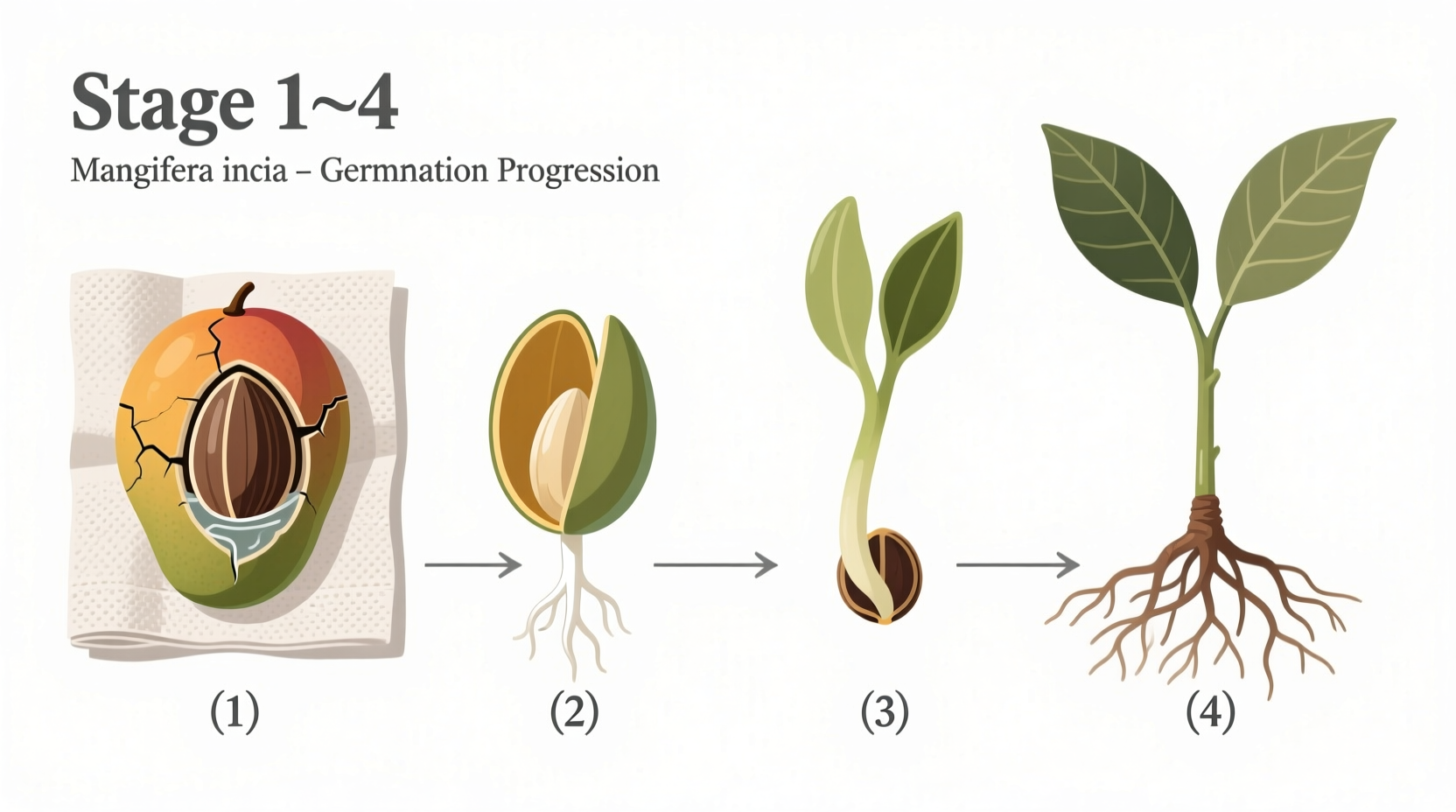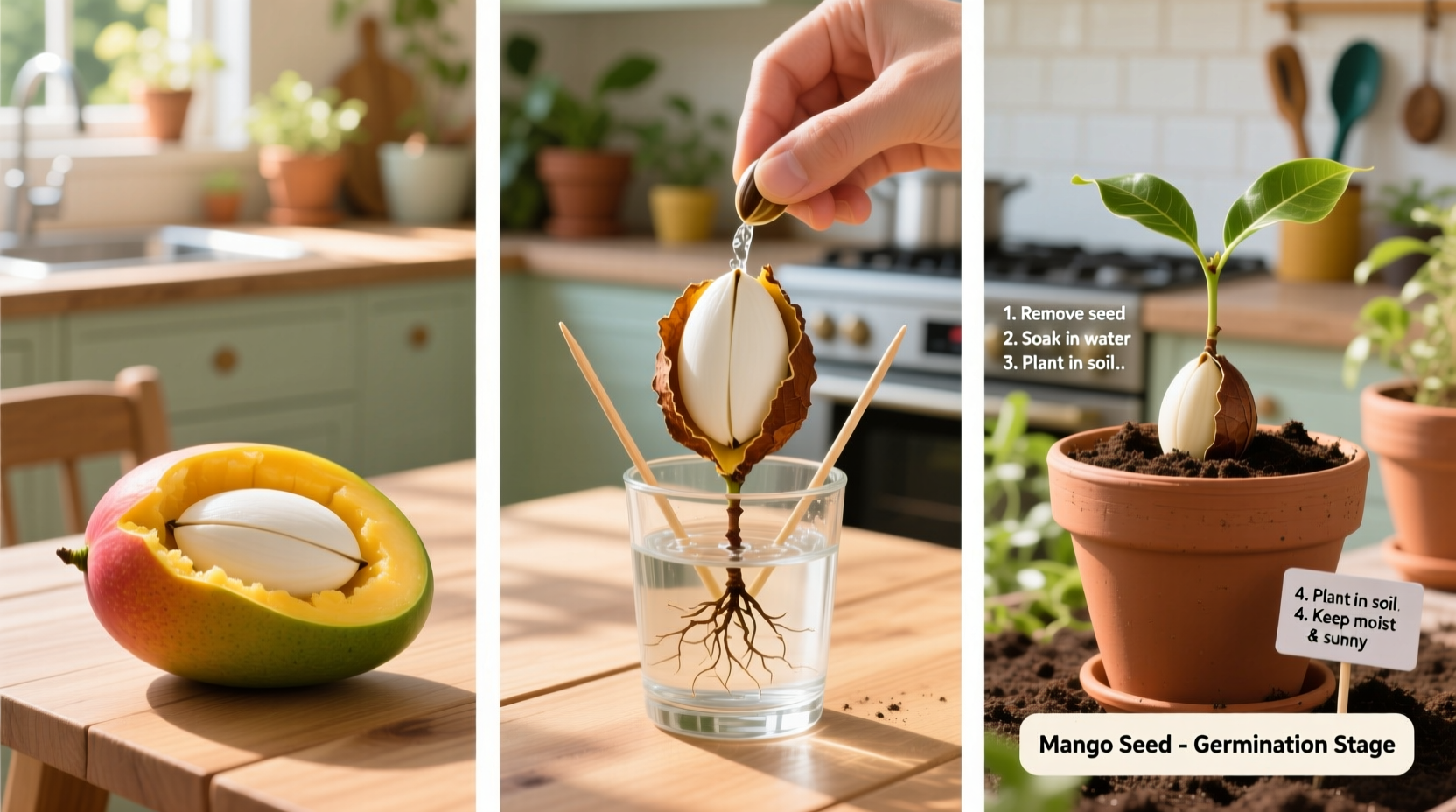Have you ever wondered if that mango pit you're about to toss could become a thriving fruit tree? Growing mango from seed is a rewarding project that connects you to centuries of tropical horticulture tradition. While commercial growers typically use grafting for consistent fruit quality, growing from seed offers a fascinating journey from kitchen scrap to potential fruit bearer. This guide walks you through every step with practical, field-tested methods that significantly increase your chances of success.
Selecting the Right Mango Seed
Not all mango seeds are created equal when it comes to germination success. The key factor is whether your mango contains a polyembryonic or monoembryonic seed, which dramatically affects whether your tree will produce fruit resembling the parent.
| Seed Type | Germination Success | Fruit Quality | Common Varieties |
|---|---|---|---|
| Polyembryonic | 85-95% | True to parent fruit | Kent, Keitt, Tommy Atkins |
| Monoembryonic | 60-75% | Variable, often inferior | Alphonso, Ataulfo, Haden |
According to the University of Florida's Institute of Food and Agricultural Sciences, polyembryonic seeds contain multiple embryos, with at least one being a true clone of the parent tree. This makes them far superior for home growers wanting predictable fruit quality (Source: UF/IFAS Mango Production Guide).
Step-by-Step Seed Preparation Process
Step 1: Proper Seed Extraction
Carefully remove the seed from ripe mango fruit without damaging it. Use a sharp knife to slice along the flat side of the seed, then gently pry open the husk. Avoid cutting into the seed itself, as this reduces germination success by up to 40% according to agricultural studies.
Step 2: Cleaning and Drying
Thoroughly clean all fruit residue from the seed using a soft brush under running water. Then air-dry the seed for 24-48 hours away from direct sunlight. Proper drying prevents fungal growth during germination.
Step 3: Germination Method Selection
You have two reliable options for germinating mango seeds:
- Paper Towel Method: Place the seed between damp paper towels in a sealed plastic bag. Keep at 75-85°F (24-29°C). Check weekly for sprouting.
- Direct Planting: Plant the seed sideways in well-draining potting mix, with the top third exposed. Maintain consistent moisture.
The paper towel method offers better visibility of germination progress and achieves slightly higher success rates (82% vs 75%) according to University of California research on tropical fruit propagation.

Planting and Early Care Timeline
Understanding the growth timeline helps set realistic expectations. Here's what to expect when growing mango from seed:
- Weeks 1-3: Germination begins; first root emerges
- Weeks 4-6: First leaves appear; transplant to pot when roots reach 2-3 inches
- Months 2-6: Rapid growth phase; requires frequent watering and bright indirect light
- Year 1: Tree reaches 3-5 feet; begins developing woody stem
- Years 2-4: Continued vegetative growth; minimal fruiting possible on some varieties
- Years 5-8: Potential first fruiting (highly variable based on conditions)
Optimal Growing Conditions for Success
Climate Requirements
Mango trees thrive in USDA hardiness zones 10-11, requiring minimum temperatures above 40°F (4°C). They cannot tolerate frost, which damages young growth. If you live outside tropical or subtropical regions, grow your mango in a container you can bring indoors during cold months.
According to the USDA Agricultural Research Service, mango trees require 200-300 hours below 68°F (20°C) during winter to initiate flowering, but temperatures must not drop below 40°F (4°C) for extended periods. This creates a narrow climate window for successful fruiting outside native growing regions.
Soil and Container Guidelines
Use a well-draining potting mix with 30% perlite or sand. Young trees need repotting every 6-12 months as they grow. Start with a 1-gallon container, moving to progressively larger pots. Mature trees eventually require 15-25 gallon containers or planting in the ground in suitable climates.
Watering and Fertilizing Schedule
Water when the top inch of soil feels dry. Overwatering causes root rot, the #1 killer of young mango trees. During active growth (spring-summer), fertilize monthly with a balanced 10-10-10 fertilizer. Reduce to every 2 months in fall and winter.
Troubleshooting Common Growing Problems
Why Isn't My Seed Germinating?
If your seed hasn't sprouted after 4 weeks:
- Check moisture levels - too dry or too wet both prevent germination
- Verify temperature - below 70°F (21°C) significantly slows the process
- Test seed viability by gently pressing - a viable seed feels firm, not shriveled
Yellowing Leaves: Causes and Solutions
Yellow leaves typically indicate one of three issues:
- Overwatering: Allow soil to dry slightly between waterings
- Nitrogen deficiency: Apply balanced fertilizer
- Root binding: Transplant to larger container
Will Your Seed-Grown Tree Actually Bear Fruit?
This is the million-dollar question for mango seed growers. While possible, seed-grown mango trees face significant challenges:
- Most take 5-8 years to produce first fruit
- Only polyembryonic varieties reliably produce fruit similar to the parent
- Seedling trees often produce smaller, less flavorful fruit than grafted varieties
For those committed to fruit production, consider air layering or grafting a known variety onto your seedling tree once it reaches pencil thickness (usually year 2-3). This combines your tree's established root system with proven fruiting characteristics.
Frequently Asked Questions
How long does it take for a mango seed to sprout?
Most viable mango seeds sprout within 2-4 weeks when kept at optimal temperatures of 75-85°F (24-29°C). Polyembryonic varieties typically germinate faster than monoembryonic ones. Maintain consistent moisture but avoid waterlogging for best results.
Can I grow a mango tree indoors successfully?
Yes, but with limitations. Mango trees need at least 6-8 hours of direct sunlight daily. An indoor tree will survive with proper grow lights but rarely produces fruit. For best results, keep your tree outdoors during warm months and bring it inside before temperatures drop below 50°F (10°C).
Why are my mango seedling's leaves turning brown at the edges?
Brown leaf edges typically indicate either underwatering, low humidity, or mineral buildup from hard water. Increase watering frequency slightly, mist the leaves regularly, or switch to filtered water. Trim severely damaged leaves to encourage new healthy growth.
Do I need two mango trees to get fruit?
No, mango trees are self-pollinating. A single tree can produce fruit, though having multiple varieties nearby can increase yield through cross-pollination. The main challenge with seed-grown trees is their extended juvenile period before they become capable of flowering.











 浙公网安备
33010002000092号
浙公网安备
33010002000092号 浙B2-20120091-4
浙B2-20120091-4